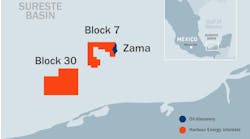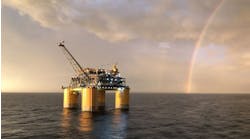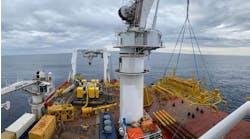LNG remains the method of choice offshore, but the technology must be altered to focus on applications with smaller production flows over shorter periods of time.
Oil and gas producers will soon have to make difficult decisions on how to capture natural gas reserves or gas associated with commercial oil fields far from markets or transportation infra structure. More countries are forbidding the flaring of associated gas and few fields are candidates for gas re-injection because of geology or additional cost.
In addition, a new benefit has surfaced, especially for countries that had not valued the resource previously. Gas is becoming valuable in markets favoring it for environmental reasons. Gas demand growth is backing out coal use and displacing some fuel oil in power generation and residential markets. The global demand for gas is expected to rise significantly in the years to come.
An additional change is the development of spot markets for gas, and provisions for buying and selling of volumes of gas that are less than contract volumes. Existing LNG terminals can be used to receive smaller volumes of gas.
Conversion choices
Producers with gas fields or non-injectable natural gas streams will have to choose whether to attempt to convert gas streams offshore or embark on the pipeline route. When electing to convert the gas, producers in the future will have four methods of conversion: temperature liquefaction, gas hydrate or some other means of solidification, chemical reformulation (syncrude, methanol, etc.) or incredibly enough, a mixture of these. In any case, the goal is to create a liquid, solid, or slurry form of hydrocarbon that is economically suitable for transport to re-gasification facilities.
Parameters playing a role ultimately in the choice of conversion process include life-of-field, production decline curves, gas flow volumes and pressures, number of wells, chemical makeup of the gas stream, water depth, metocean conditions, mooring, length of the transport phase, and re-gasification methods and access.
Because stranded gas (no pipelines available) and associated gas have long been problems without adequate solutions, researchers are now conducting tests on LNG, synthesis gas, and hydrate solutions to determine both technological as well as commercial challenges ahead.
LNG markets
The LNG or liquefied natural gas process has an 80% conversion efficiency rating, making it one of the highest in the market. LNG facilities have been in operation onshore for 30 years. At present, there are LNG facilities on bottom-fixed barges in a near-shore environment.
The installation of an LNG unit on a floating production, storage, and offloading (FPSO) vessel is approaching, but there remain minor uncertainties regarding the efficiency of an LNG process that must endure all-weather environments.
A European Commission project (Azure) is investigating the challenges associated with the installation of the liquefaction facility on board an FPSO, as well as installing the LNG re-gasification unit on an offshore floater. The latter would be connected to existing pipeline infrastructure offshore or onshore. The re-gasification unit, besides being highly mobile, does not require dredging and expensive port facilities associated with present onshore re-gasification plants.
Working on the Azure project is Bouygues Offshore, project coordination and alternative concrete hulls, M. W. Kellogg, offshore liquefaction, Chantiers De l'Atlantique, a steel FPSO hull, Fincantieri, floating regasification terminal, and FMC, the open-seas LNG transfer systems.
Liquefaction of produced natural gas streams depends greatly on the volume of the well or collective field production flows and the production decline curve. The cost of an LNG facility, along with the required shuttle tankers and re-gasification plant, is such that suitable flows over long-term contracts are required to make the installation profitable. Three liquefaction processes are presently in use on onshore LNG facilities:
- Mixed refrigerant cycle
- Cascade refrigerant cycle
- Expander cycle.
The first two are used on fields with large flows with high up-time loading rates, while the third choice is being examined as the likely choice for smaller fields where flows may be intermittent. The expander cycle uses refrigeration provided by compression and expansion of nitrogen or methane.
Other advantages accruing to the expander cycle, according to Claude and Durupt (see references), is safety and relative compactness. The latter means a smaller footprint on a vessel. These are said to compensate easily for the larger power consumption and cost required for the expander cycle technology.
Gas-to-liquids
Chemical gas-to-liquids conversion has a conversion efficiency rating of about 60%, rather low when compared to LNG's 80% rating. To date, there are no offshore applications of a chem ical conversion of gas-to-liquids (the LNG process involves cryogenic conversion). A small number of companies have perfected some elements in the process and have systems in trial, however, there are only 3-4 applications underway onshore. Although the process ultimately may be very successful, offshore trials are some time off.
The gas-to-liquids process involves a two stage process where a synthesis gas is formed in the first stage, and the gas is reacted to produce a fuel product, or compressed and distilled to form methanol. In the formation of a synthesis gas (carbon monoxide and hydrogen) from methane oxidation, Claude and Durupt (see reference) cite a number of technologies available for the reformation stage:
- Thermal partial oxidation with oxygen
- Thermal partial oxidation with a catalytic agent
- Steam reforming
- Steam combined with thermal partial oxidation
- Autothermal reforming
- Gas heated reforming.
Oxidation of the methane in stage 1 requires a cryogenic air separation process to produce the pure oxygen needed. Afterward, the synthesis gas goes to one of two steps:
- Fischer Tropsch reaction, producing petroleum products such as fuels and lubricants
- Combined compression and distillation, resulting in methanol, which can be used as a feedstock in additives or formaldehyde production.
One disadvantage of the gas-to-liquids process is that the generation of pure oxygen is difficult to sustain in an offshore environment without some type of filtration process. The development of new reformation technologies, such as new ceramic membranes, can simplify the process, but wide tests have yet to be run on many of the new systems.
Claude and Durupt say that moderate volumes of associated gas are good candidates for a gas-to-liquids plant aboard an FPSO, although much work needs to be done on proving the concepts.
Gas hydrates
As cited earlier, the conversion of natural gas, following processing and treatment to a hydrate form is in the early stages of investigation. One of the major benefits to hydrate transport is that the cargo can be maintained at atmospheric pressure, although it would have to be kept refrigerated at a temperature below -10°C.
Researchers are even more excited about the mixing of gas hydrates with chilled crude oil to form a stable slurry. Reaching destination, the slurry mix would have to be separated and inserted in separate lines, which could be a problem for some producers or locations.
Hydrates form at temperatures of 5-15°C and at atmospheric pressures of 50-100 bar. The slurrification (hydrates and crude oil) process involves the reaction of gas, cold water and crude at the temperatures and pressures cited above, and routing of the forming slurry into a flash tank, before pumping to a storage-transport vessel.
One interesting research finding, according to Claude and Durupt, is that laboratory tests have "not yet achieved the theoretical gas content per cu meter of hydrates."
Methanol conversion
The conversion efficiency of methanol production is about 65%, slightly more than gas-to-liquids, but far less than LNG. Methanol production from natural gas is a relatively proven process and is widely used onshore. At present, there are no offshore applications. There are two disadvantages associated with methanol conversion and a reason why there isn't very much pressure to install facilities offshore:
- Markets: The market demand and prices for methanol vary considerably, and the plant could be running at or below operating cost for periods of time. Not much market growth is expected, although Asian markets present interesting possibilities. MTBE has been a major market for methanol, but some governments are looking at potential environmental impacts, so there may be problems in the future.
- Capital cost: Methanol conversion is fairly costly, and approximates the cost of a gas-to-liquids facility.
- Safety: Since the first step in methanol conversion is oxidation, the process presents the same safety issues as the gas-to-liquids process.
On the positive side, methanol conversion is ideal for smaller gas fields.
Conclusions
Claude and Durupt say the gas-to-liquids conversion process may have a great future because of environmental pressures, but the technology still has a ways to go before offshore consideration. Another technology with a significant future, but weak technology, is the transport of gas hydrates, although the slurrified oil-hydrate form will likely be the target of closer investigation. The markets for methanol are questionable enough to make this conversion choice least preferred, at least for the present.
LNG remains the method of choice offshore, but the technology must be altered to focus on applications with smaller production flows over shorter periods of time. Applications aboard FPSOs might make the size of field or flow volumes no longer a consideration.
The simplified model used in a dual choke completion application. The reliability performance figures apply for the downhole components of the Admarc system, from the tubing hanger wet mate connectors, down.
References:
Claude, J., Durupt, L., "Valorization of Associated Gas of Deep Offshore Fields," Deep Offshore Technology Conference & Edxhibition, Stavanger, Norway, October, 1999.
Marchand, D., Martin, M., Sheffield, J., "Project Azure: Towards the Reality of Producing LNG on an FPSO," Kellogg-Bouygues paper, October 1999.
El Aiba, S., Vache, M., "The GBS Import Terminal," International Journal of Hydrocarbon Engineering, April, 1998.


